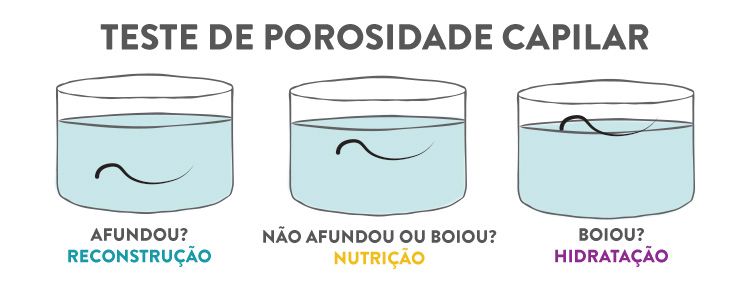Your hair is opaque, dry, brittle and you don’t know what else to do? How about starting a hair recovery schedule?
Constant exposure to sun, moisture, dry weather, wind, pool water, sea, chlorine and chemical processes can directly interfere with hair health.
And even with various care it is possible that the hair may be difficult to recover, and when this occurs, it is time for intensive treatment.
To learn more about the hair schedule and how to do it, keep reading this post and know the steps, tips and recipes to do at home.

Capillary schedule
To keep your hair beautiful and healthy some care is needed, such as hydration, nutrition and reconstruction.
And for this, there is the hair schedule, a treatment method indicated for all hair types and lengths, which helps in the promotion and maintenance of healthy hair.
But before you know where to start, you need to identify the damage and needs of the wires, allowing a complete and effective treatment.
Therefore, doing the porosity test on the wire is essential in order to understand what level of damage your hair is.
To do the test, take a glass of water, put on a strand of hair and wait for 10 minutes.

The porosity of the hair indicates how damaged and weak the hair is.
If your hair is with high porosity or very damaged, in the test it tends to sink and this, indicates the need to reconstruction.
Generally this type of wire suffers from chemical processes and high temperatures, such as brush, plate, smoothing and dyeing.
Wires with average porosity or little damaged remain in the middle of the glass, neither sinking nor floating and this indicates lack of nutrition.
This type of hair suffers from the loss of natural oiliness and lipids, which causes weakness, opacity and lack of flexibility in the hair.
Curly and curly hair often needs to replenish their nutrition, since the curves of the curls prevent the oiliness and vitamins from reaching the length, resulting in double ends, dry and speckled.
But if in the test your wire floated, it indicates low porosityIt is only necessary to make a schedule of hydration.
This type of lag produces the loss of water and dry effect and no elasticity.
After identifying your hair’s need, it’s time to trace the steps of the treatment and know its steps.

Hydration
Hydration in the hair, aims to replace water and vitamins lost from daily actions and also over time.
The main substances that promote hydration in hair are coconut oil, babosa, D-pantenol, avocado and jaborandi, so if your hair is in this stage of treatment, look for products or recipes that contain some or combinations of these ingredients.
Nutrition
The nutrition of the hair in the capillary schedule, has the function of replacing the lipids and nutrients lost over time.
To replenish these nutrients and protect the threads again, vegetable oils are used as argangrape seed, shea, olive, cocoa, murumuru, cupuaçu and castor bean.
At this stage the humectanting with some of these oils is fundamental to return the brightness and sealing of the cuticles.
Reconstruction
The reconstruction will restore the hair mass from proteins and amino acids that have been lost from its structure.
Chemical processes such as straightening, progressive brushing and relaxation can contribute to this lag, it allows a thin, brittle and dry hair look.
And to perform the reconstruction on yarn, proteins such as keratin, creatine and arginine are important, as well as other ingredients such as ceramides and collagen.
After knowing the steps, it is necessary to trace the steps and how to make the hair chronogram.

How to make a hair schedule?
To make the hair schedule is necessary to define a few days a week, products and ingredients appropriate to the need of the hair.
The types of care and amounts of hydration, nutrition and reconstruction should follow the porosity defined according to the test with the yarn in the glass of water.

The treatment initially lasted 4 weeks and in this period it is possible to notice positive results, however in some cases it is necessary to extend this period a little more.
For best results it is recommended to take a 48 hour break between each treatment, this will help the yarn to absorb vitamins and nutrients gradually and healthily.

See also: Capillary Botox, everything you need to know.
Home hair chronogram
After identifying the needs of the hair, the periodicity and type of treatment at each stage it is possible to start with home care.
Choosing the right products and ingredients is very important for the end result.
Below are some easy, home-made recipes specific to each type of hair schedule.

Step by step to Hydration Schedule
To start the hydration routine it is necessary to define the products and ingredients that will be used in the recipes.
In this schedule, the hydration prescription will be made more times during the month, followed by nutrition, being three times during the process and then reconstruction, being only once in the last week.
The reconstruction is done only once, because as the hair already presents health and mass in the strands, by exaggerating the collagen and keratin, for example, the hair can suffer the reverse effect, damaging even more the hair.
Hydration with Bepantol
Bepantol has several benefits to the skin and hair, so using it in this hydration will help in the maintenance of water in the structure of the wire for longer, resulting in softness and lightness.
The necessary ingredients are:
- 1 tablespoon of Bepantol solution;
- 2 tablespoons cornstarch or cornstarch;
- 1 tbsp (tablespoon) of hydration mask; and
- 150 ml of water.
In a small pot, put the water, the maisena and take it to medium heat, stirring until it thickens.
After turning a cream, transfer to a container and wait to cool; after adding Bepantol and the hydration mask.
Mix the recipe well until it forms a homogeneous cream.
To make the application:
- Wash your hair with salt-free shampoo and warm water;
- Dry the threads well, removing all excess water;
- Separate into locks and apply the mixture by glossing the entire length of the hair;
- After applying to all locks, lock the hair and leave it on for 30 minutes with a plastic cap;
- After the period, rinse with cold water and finish with the conditioner.
Perform this hydration on the days corresponding to the schedule and do not forget the interval for the next step.
Nutrition with extra virgin olive oil
This recipe for nutrition will leave the hair loose and with incredible shine and can be done on all hair types.
For this recipe you will need:
- 2 tablespoons of extra virgin olive oil; and
- 1 tablespoon brown sugar.
In a container, mix the oil with the brown sugar until it is homogeneous and start the process of application on the threads.
At this stage it is not necessary for the hair to be clean.
- Separate the hair into small strands;
- Apply the mixture to the entire length and also to the root;
- Fix your hair with a coke and let it act for 30 minutes;
- After the stipulated time, rinse with cold water and conditioner.
If necessary, use the conditioner more often until all the oil is removed from the threads.
This nutrition will be done 4 times during the entire hair hydration schedule with a period of one month.
Reconstruction with gelatin and slime
The slime in the hair is indicated to give strength and shine and with the gelatine, it will allow a healthy reconstruction in the structure of the hair.
For this recipe, you will need:
- 1 tablespoon of colorless gelatine;
- 100 ml of water;
- 1 tablespoon reconstructive mask; and
- 1 tbsp (tablespoon) of babosa gel.
In a glass container, place the water, the gelatine, stir with a spoon and take to the microwave for 30 seconds;
After heating, add the reconstructive mask, the drool gel and mix until homogeneous.
- Wash your hair with shampoo;
- Dry the threads well with a towel in order to remove all excess water;
- Separate the hair into not too thick strands;
- Apply the recipe by glueing the wicks until it penetrates the wire;
- Leave for 20 minutes and then rinse with cold water to seal the cuticle.
In the hair hydration schedule, this prescription should be made once a month.

Step by Step for Nutrition Schedule
In the hair nutrition schedule, this step should be done 4 times a month and will help the hairs to recover the lipids and natural protection.
The threads will become soft, shiny and healthy looking.
Hydration with coconut oil and sugar
Coconut oil is a widely used ingredient for its vitamins and nutrients.
At this stage of the hair nutrition schedule, it will help repair the damage to the hair, in addition to helping maintain hydration for longer.
For this hydration will be necessary:
- 100 ml of milk;
- 1 tablespoon of cornstarch;
- 1 tablespoon coconut oil; and
- 1 teaspoon sugar.
In a pan, take the milk and cornstarch to the fire, until it forms a porridge. Then place a container and wait to cool.
Mix the sugar and coconut oil in the porridge until it forms a cream.
- Wash your hair with shampoo;
- Remove all excess water with the towel and separate the hair into locks;
- Apply the cornstarch paste and coconut oil along the entire length of the thread, massaging the strands;
- Attach your hair, put on a thermal cap and leave it on for 30 minutes;
- Rinse with cold water and conditioner.
In the first days of hydration, if you want to maximize the results, add 1 tablespoon of Bepantol solution.
This product will help to keep vitamins and look healthy longer in the yarn.
Nutrition with castor oil
Humectancy is widely used in hair nutrition and if your hair is curly, you’re sure to love the results, as it will leave the curls well defined and shiny.
The elimination of frizz and malleability are other main benefits perceived right after the first care session, so follow the schedule and do it correctly on all stipulated dates.
This will help keep the wires healthy longer.
You’ll need it:
- 30 ml of castor oil.
It is not necessary to wash the hair previously, so, for better results, this recipe should be applied to dry hair.
In a container, place the castor oil and take it to the microwave for 15 seconds.
- Separate dry hair into locks;
- Apply castor oil by glueing the wicks;
- Massage the scalp with a little oil;
- Attach your hair and put on a metallic cap;
- Let it go for 30 minutes;
- Wash with shampoo and conditioner.
This nutrition should be done 4 times during the capillary chronogram and if you wish, interchange with the nutrition recipe with extra virgin olive oil.
Reconstruction with maisena and liquid keratin
Maisena in the hair helps in the softness and shine, while the keratin promotes the reconstruction and recovery of the structure of the wire.
This recipe is very simple, you will need it:
- 200 ml of water;
- 2 tablespoons cornstarch or cornstarch; and
- Liquid keratin.
In a pan, put the water, the maisena and take it to medium heat until it thickens.
Place in a container and allow to cool, after sprinkling or dripping 5 drops of keratin and mix until homogeneous.
- Wash your hair with shampoo at least twice to ensure the strands are well cleaned;
- Separate the hair into strands and apply the maisena with the keratin, glossing the hair;
- Lock your hair and wait to act for 15 minutes;
- After the established time, rinse your hair with cold water and finish as usual.
This step should be done only once a month and do not overdo keratin.

Step by Step to Reconstruction Schedule
In the hair nutrition schedule, the hair has more damage, so more care will also be needed.
Nutrition should be done 5 times during the treatment and reconstruction two times, promoting a recovery of hair fiber.
Hydration with natural yogurt
Natural yoghurt is very indicated in treatments with severe damage to hair, such as opacity and double ends.
The following ingredients are required for this recipe:
- 1 egg yolk;
- 1 tablespoon of natural yogurt;
- 1 teaspoon of extra virgin olive oil; and
- 1 tbsp (tablespoon) of hydration mask.
Put the egg yolk on a sieve and place it in a container.
Add all the other ingredients and mix until a homogeneous cream is formed.
- Wash your hair only with shampoo and remove all excess water with the aid of a towel;
- Separate the hair into locks and apply by glossing the strands;
- Lock your hair and let it act for 20 minutes;
- Then rinse your hair with cold water.
This recipe is suitable for all hair types and helps revitalize the hair.
Nutrition with chocolate powder
The chocolate powder, besides giving a great smell for mixing, allows a lot of shine and softness to the yarns.
This ingredient also has antioxidant action, which stimulates cell renewal and healthy hair growth.
The following ingredients will be needed for this homemade nutrition:
- 1 tbsp (tablespoon) of hydration mask;
- 1 tablespoon coconut oil;
- 1 spoon (dessert) of saline solution;
- 1 tablespoon chocolate powder; and
- 1 bi-distilled liquid glycerin cap.
In a container, mix all ingredients until a homogeneous cream is formed.
- Wash your hair with shampoo and then remove all excess water with a towel;
- Separate the hair into strands and apply the mixture, glossing out the entire length of the wire;
- Attach your hair, put on a cap and let it act for 15 minutes.
- Rinse with cold water and finish as usual.
This nutrition should be done once a week, for one month, according to the capillary schedule.
Homemade reconstruction with egg, milk and honey
This recipe promises to make your hair strong, shiny and moving.
For this recipe, you will need:
- 1 whole egg;
- 3 tablespoons of milk;
- 2 tbsp (tablespoons) of moisturizing mask;
- 1 tablespoon of honey; and
- 1 Tbsp of extra virgin olive oil.
In a container, place all ingredients until a homogeneous mixture is formed.
For this reconstruction application, it will not be necessary to wash the hair previously.
- Separate dry and dirty hair into locks;
- Apply the mixture, glossing the wires along the entire length;
- Lock your hair and let it act for 30 minutes;
- After that time, wash your hair normally with shampoo and conditioner.
In addition to rebuilding the threads, this homemade recipe will reduce the frizz and double ends.

The homemade hair schedule, when done properly, promotes numerous benefits and great results with relatively low investment.
Perform the hair porosity test and start the hair schedule.
This will leave your hair soft, shiny, hydrated and very healthy.
Leave us your comment and tell us about the results of your hair schedule!


